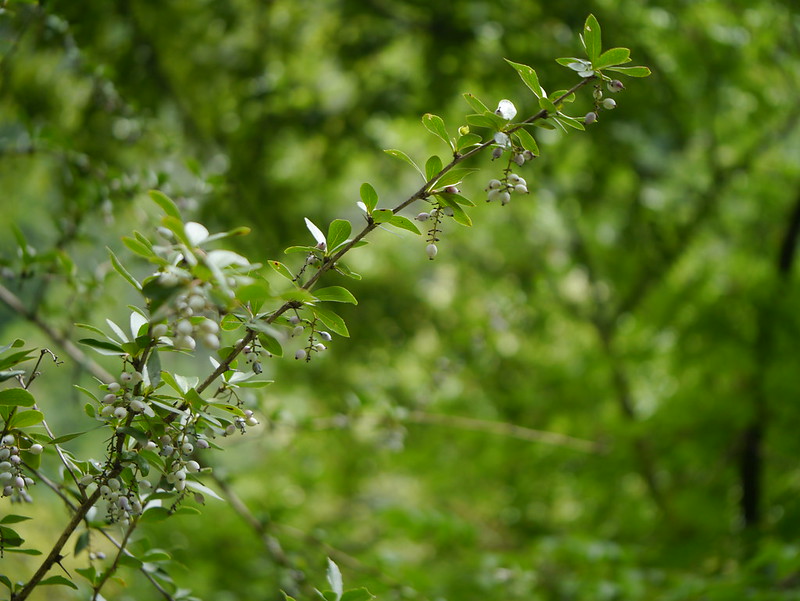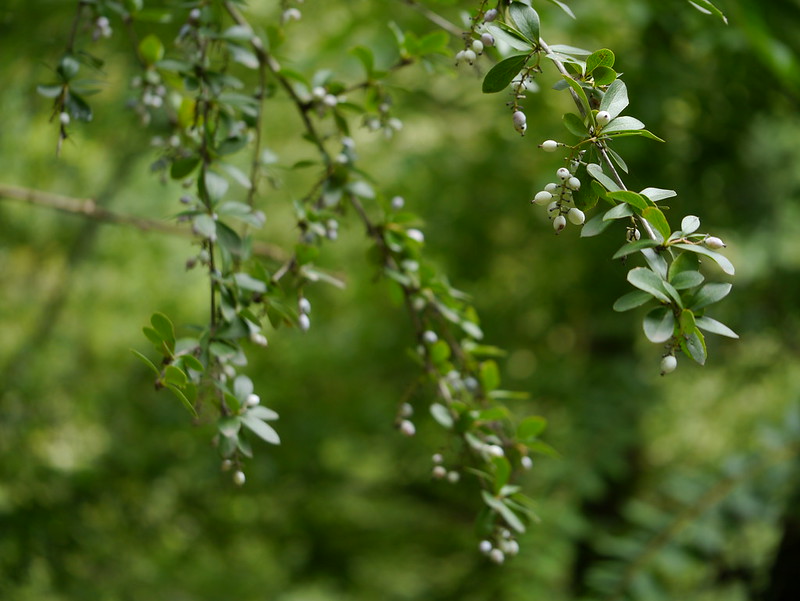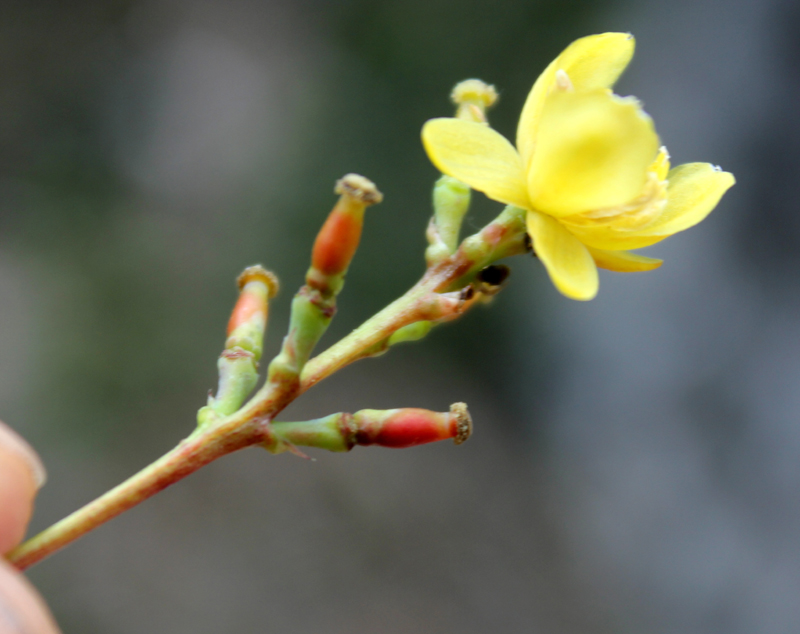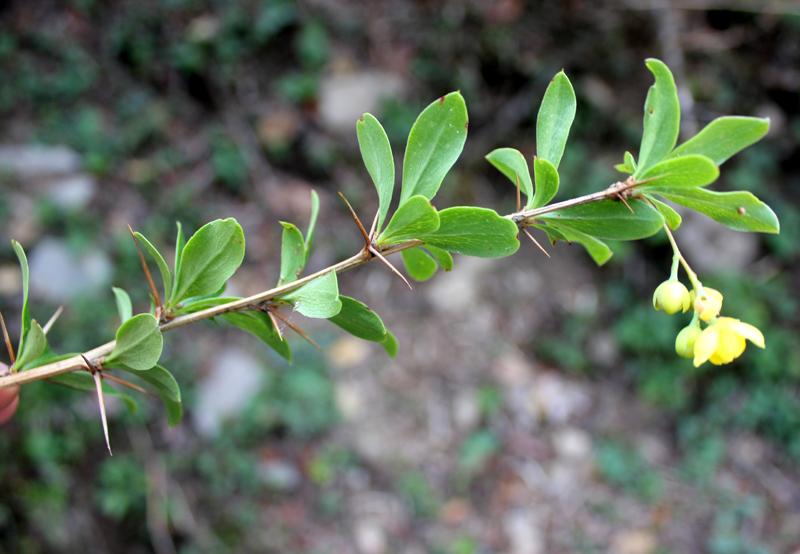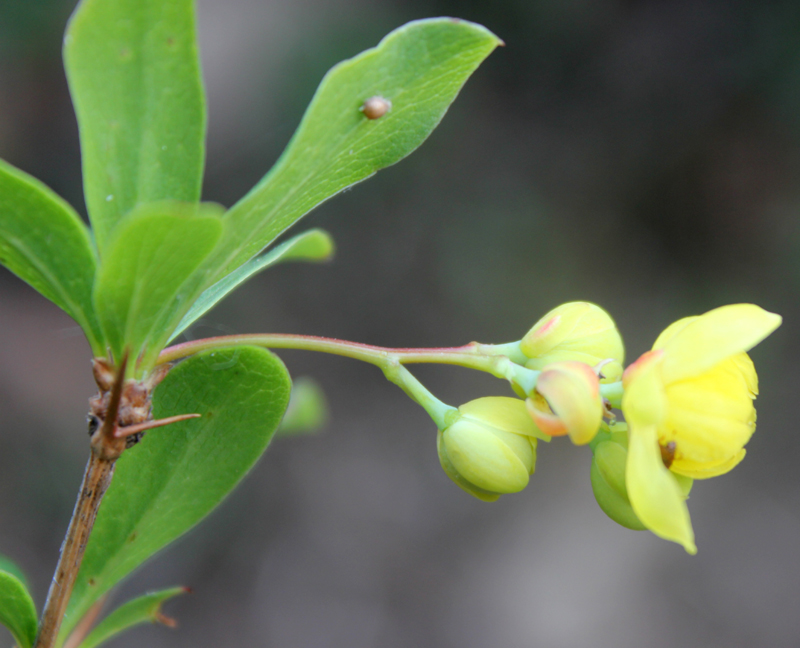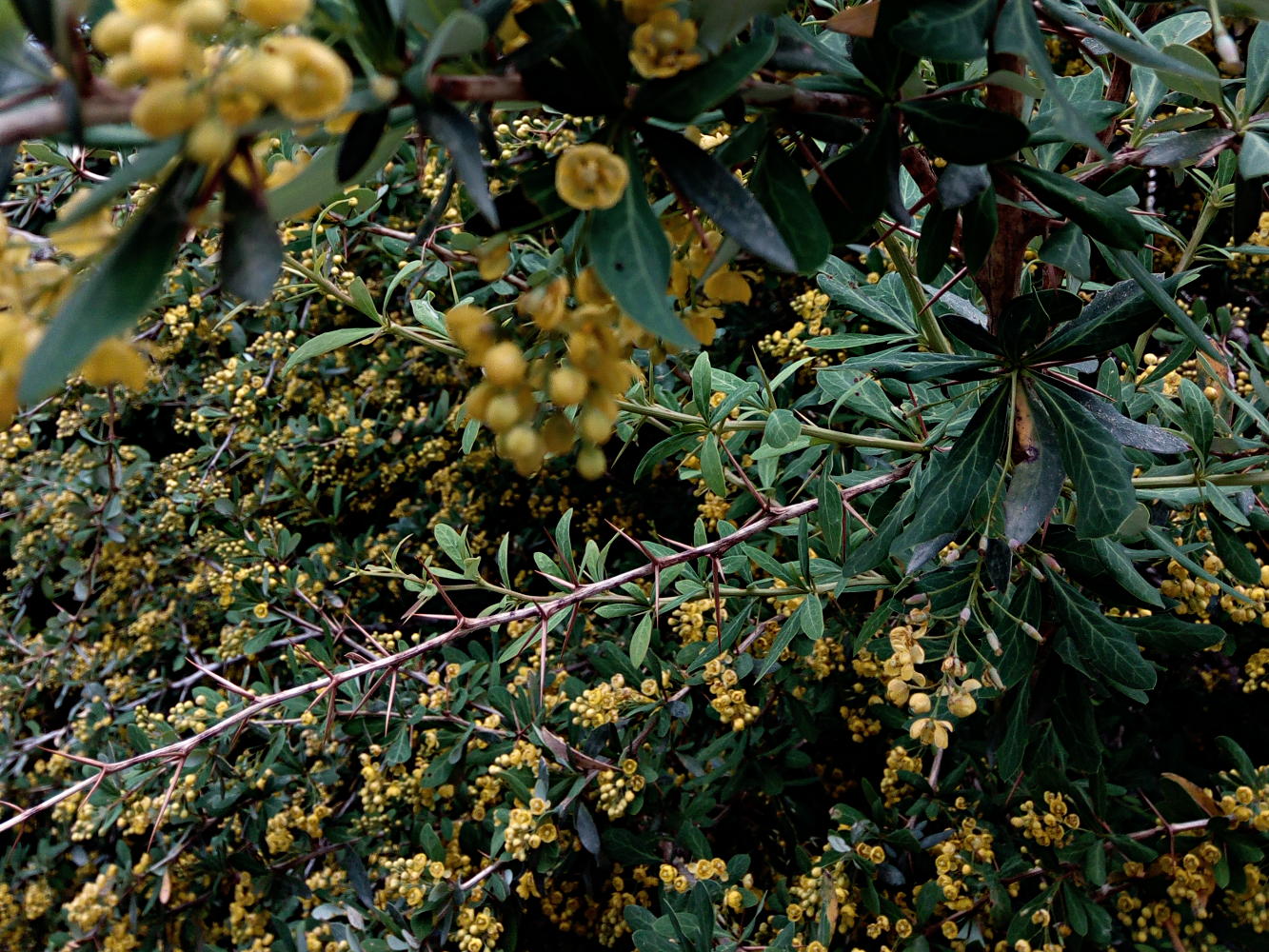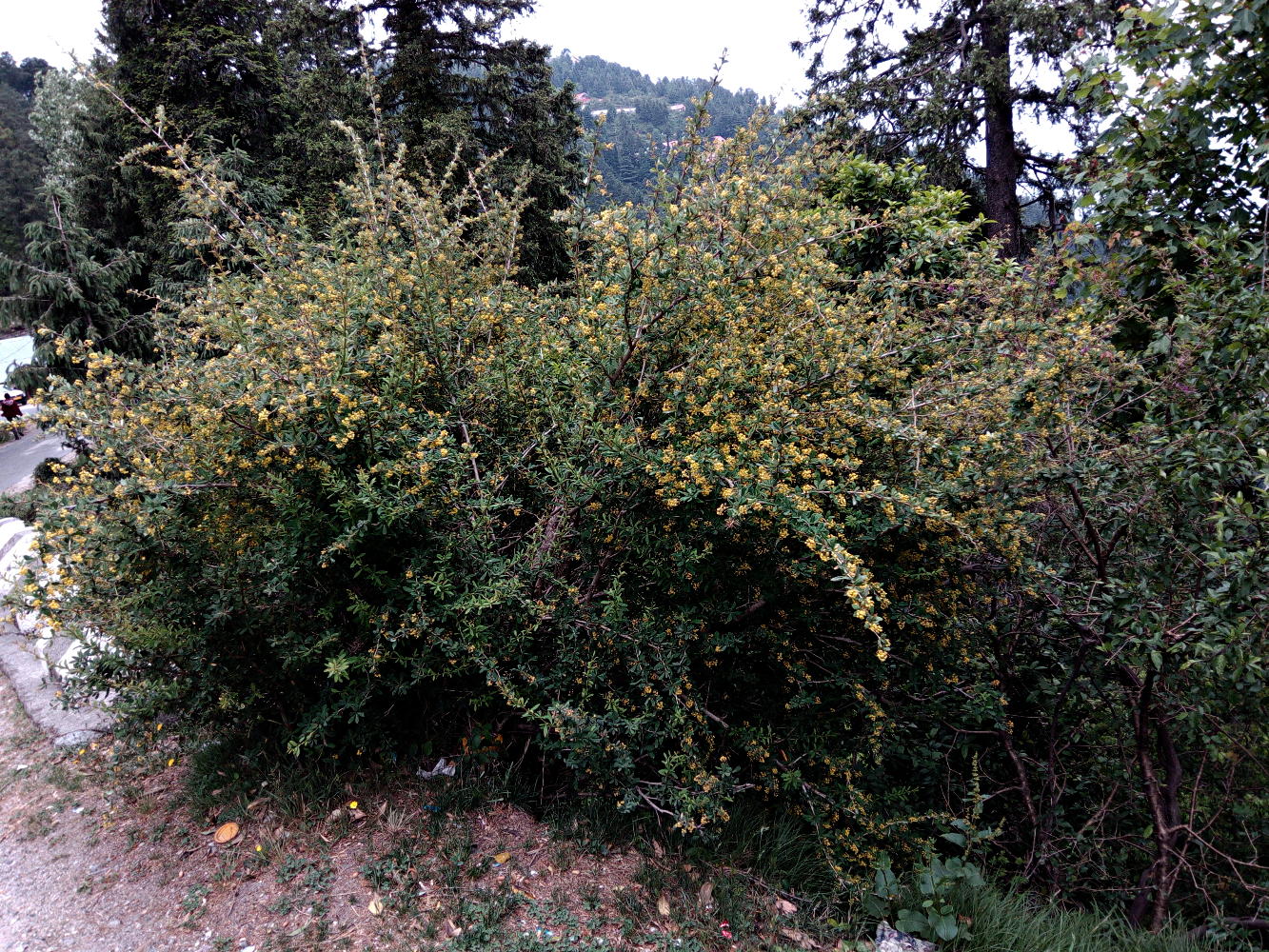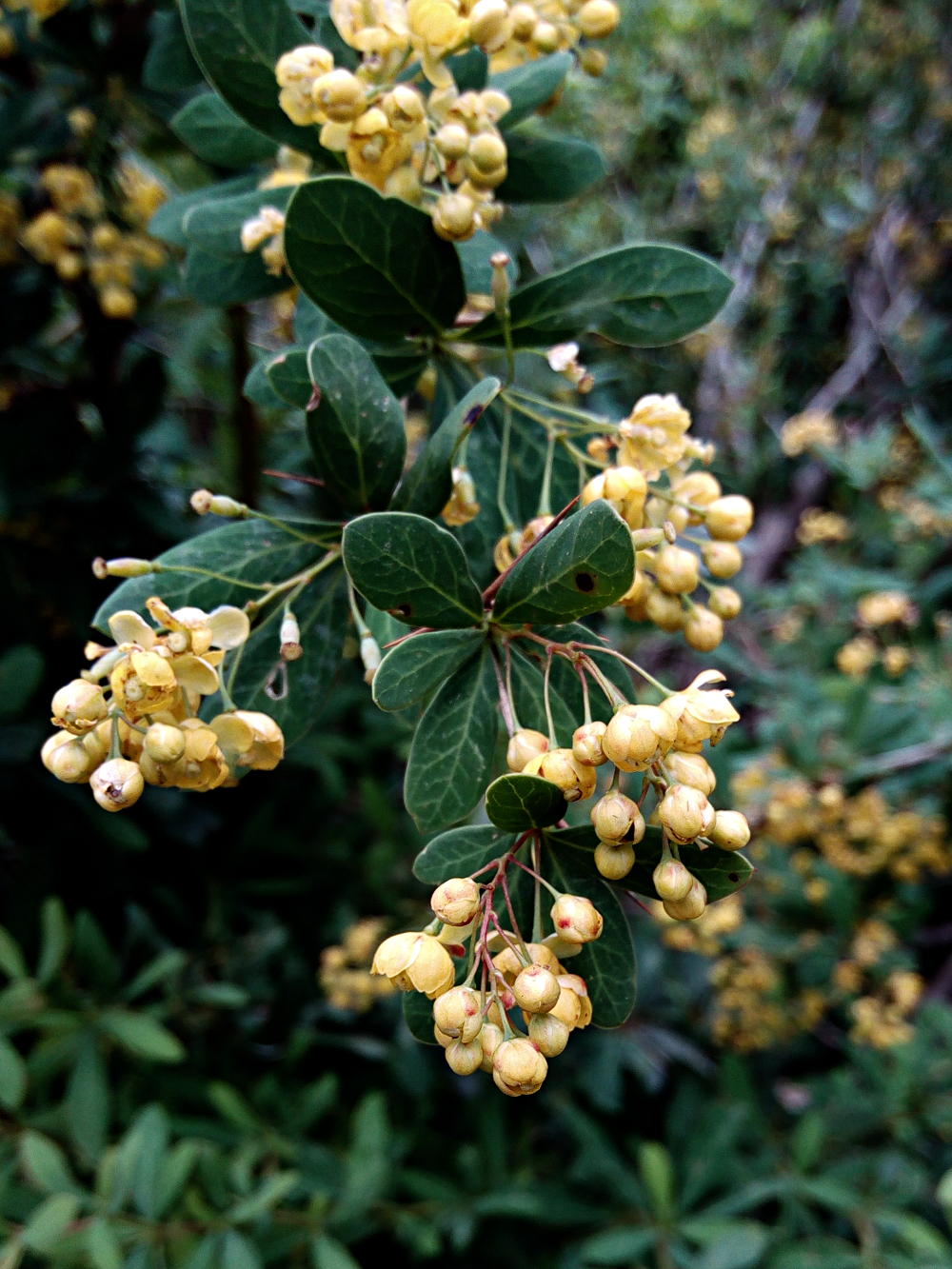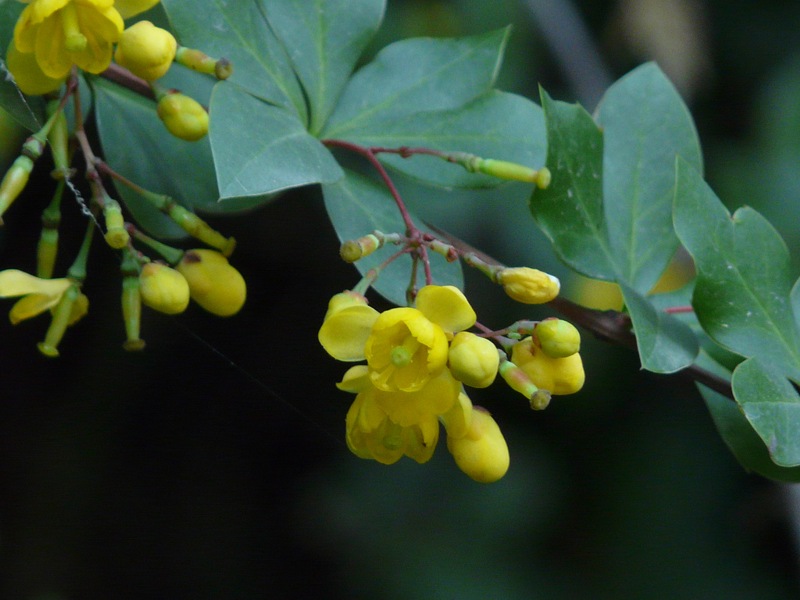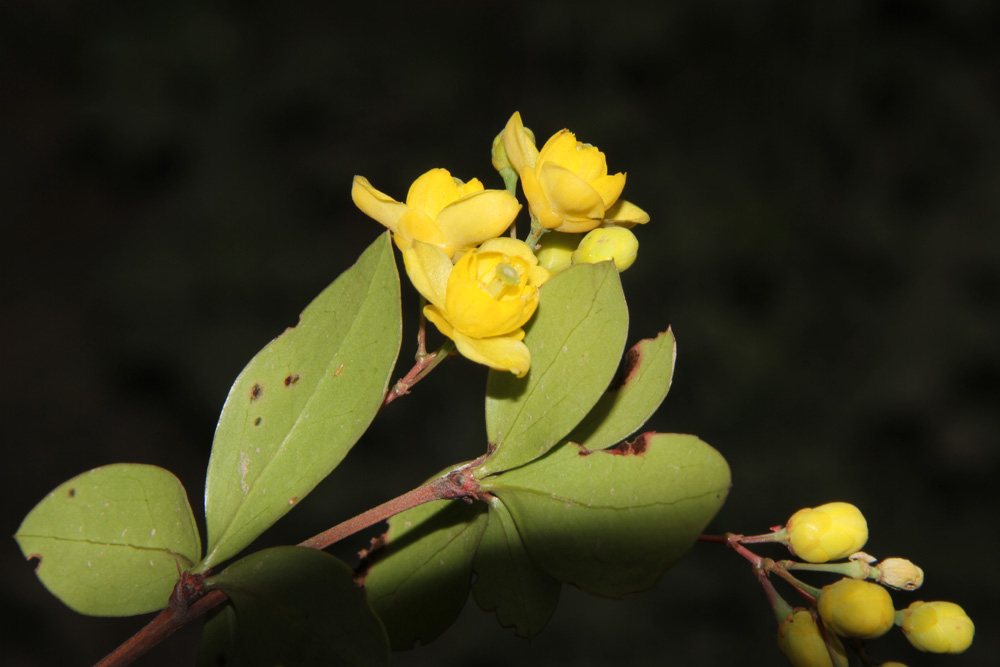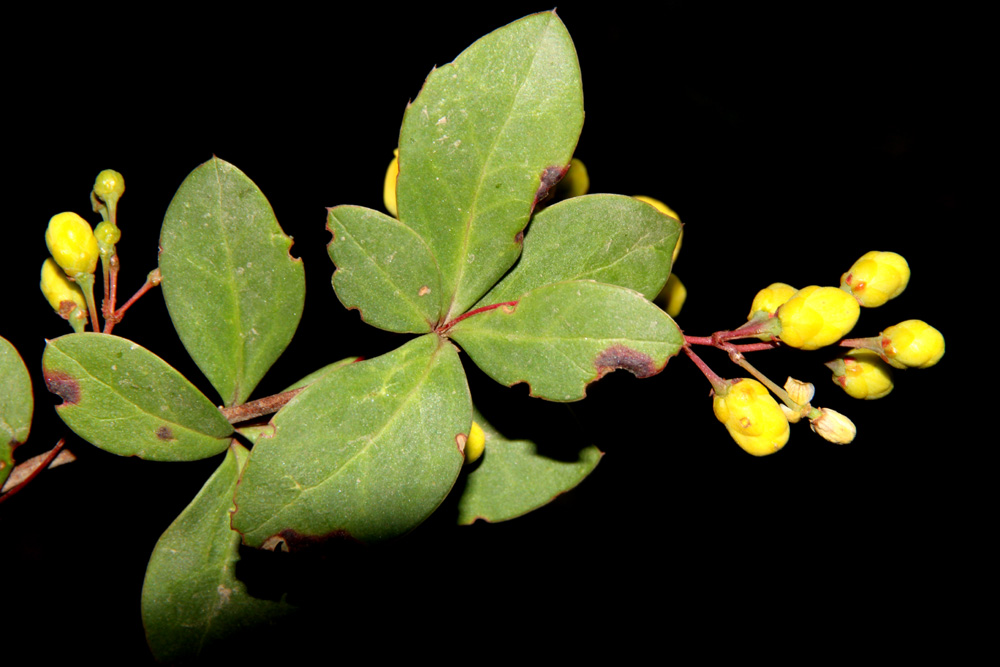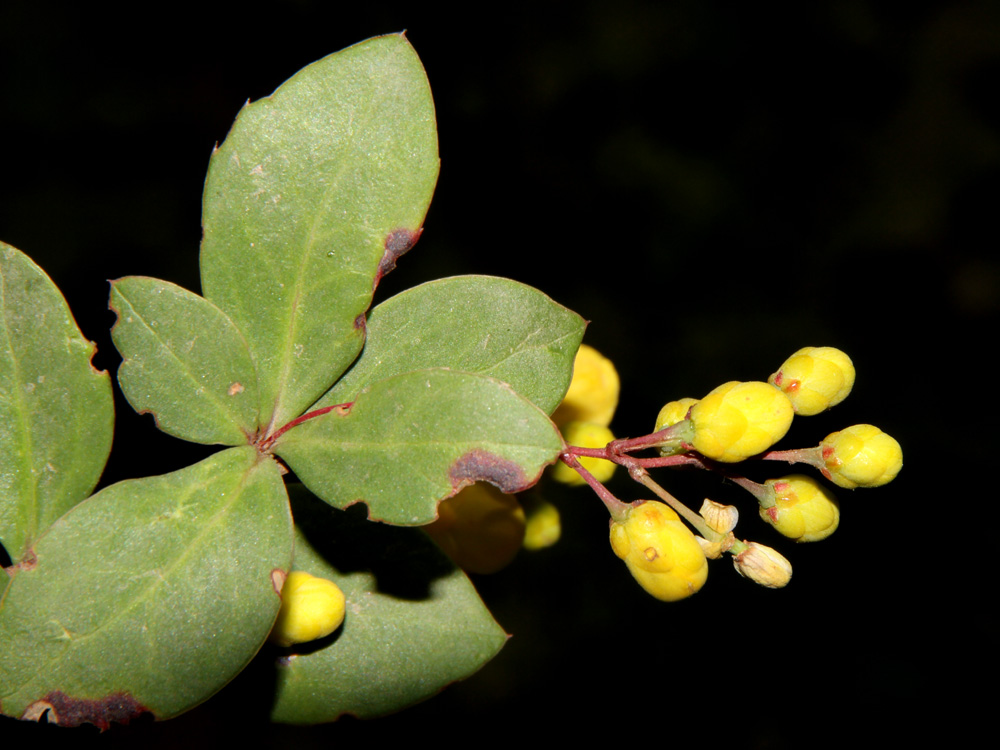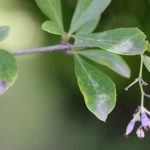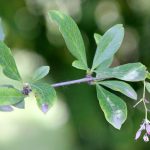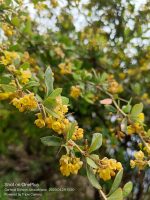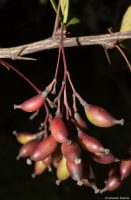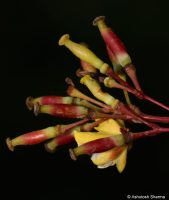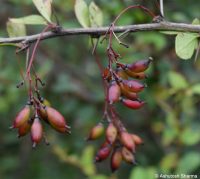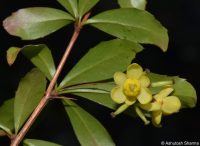|
Berberis aristata DC., Syst. Nat. 2: 8 1821. (Syn: Berberis bussmul K.Koch ex Miq.; Berberis chitria D.Don [Illegitimate]; Berberis coccinea K.Koch; Berberis coerulescens G.Nicholson; Berberis elegans K.Koch; Berberis gracilis Lindl.; Berberis gracillima K.Koch ex Miq.; Berberis macrophylla K.Koch; Berberis serratifolia K.Koch; Berberis umbellata Lindl.; Berberis undulata K.Koch);
.
DARUHARIDRA, Chitra, Indian barberry, Tree turmeric, Nepal barberry • Hindi: चित्रा Chitra • Tamil: Mullukala • Malayalam: Maramanjal • Bengali: Darhaldi;
.
VoF Week :: Berberis aristata along Govind Ghat – Ghangaria trail: 1 AUG 12 Vow.. You went there first and showing all plants first……….. Yes … I have that advantage! VoF Week: Berberis sp. along Govindghat-Ghangaria route: Yes it is. But … would be the best person to confirm the present nomenclature of this species as he is doing a revision of Berberis genera. If you just touch or rub these fruits, you will see the red colour of the fruit, which otherwise is covered by this glaucous powder.
VoF Week: 19092012 BS 17 Berberis sp for id from the way to Ghangriya: It is Berberis aristata
Menispermaceae, Berberidaceae, Nymphaeaceae and Nelumbonaceae Fortnight: Berberidaceae- Berberis lycium from Chopta, Uttarakhand-GSOCT06: 5 posts by 4 authors. Attachments (3) SK126OCT042016:ID : 10 posts by 3 authors. Attachments (8)
Sharing some pictures for ID shot at the Chandragiri Hill Kathmandu on 19 September 2016 at 8200 ft.
Could it be Berberis griffithiana var. pallida (J. D. Hooker & Thomson) D. F. Chamberlain & C. M. Hu syn: Berberis bhutanensis Ahrendt (synonym)
The plant is tall about 15 ft in height or more. Thanks for sending around nice photos. It is Berberis aristata DC. I think fruit shape is not matching with B. aristata. Please check once again. One always must be ultra cautious when suggesting species names for Berberis. I often go on about difficult genera identification-wise. This genus is seriously challenging. Mr Tebbs who prepared the account for Berberidaceae within ‘An Enumeration of the Flowering Plants of Nepal’ (Vol II, 1979) commented that his list was based mainly on the work of Ahrendt in 1961. However, various problems still remain. A critical revision of this genus is urgently needed based upon the abundant material recently collected in Nepal and adjacent regions. As far as I know the situation remains the same today! Work has been done in China (though differences of opinion have arisen) and I believe work is underway covering the extreme East of the Himalaya/NE India but how much that will help in Nepal, remains to be seen (and the Indian Western Himalaya of course). ‘Flowers of the Himalaya’ say, “Individual species are often difficult to distinguish from each other”. I have come across quite a number of Berberis in various parts of the Himalaya and remain uncertain as to their identity. So IF someone with expertise in this genus in the main Himalaya incl. Nepal exists and is available to view these images and comment with authority, that would be great but in the mean time we must be careful in our attempts at naming. For the present, I will comment as best I can, having not attempted to make a special study of Berberis in the Himalaya.
Only having a very poor pressed specimen at Kew to go on see: Kew and the information in ‘Flora of Bhutan’ Vol 1 Part 2 (1984) where the leaves are described as elliptic (which hardly fits the specimen at Kew) including it is only recorded from Bhutan and not Sikkim, making a record from the Kathmandu Valley unlikely. I do not consider it comes near to B.griffithiana. There was no record for B.griffithiana in the Nepal Enumeration.
Grierson who wrote the account of Berberidaceae for this Flora commented about the great variability within this genus numerous varieties have been created; for the sake of simplicity these were largely ignored and he discounted several old records of Berberis species supposedly found in the E.Himalaya.
As for the definite ident of B.aristata– I really cannot be sure. The fruits are immature, so that does not help and the non-close-up views of foliage do not match so images which may be reliable, such as in ‘Flowers of the Himalaya’. I also consider the closer view of the undersurface of a leaf is not consistent with the strictly limited detail I have about this species. The foliage shown in a number of pressed specimens at Kew (see e.g.: Kew) shows variation.
I have consulted ‘The Flora of Kathmandu Valley’- this lists 4 species: B.wallichiana, B.asiatica, B.chitria and B.aristata. Clearly, and with due respect, this was a highly provisional account especially for such a difficult genus. I found the descriptions of the species somewhat contradictory. Certainly, altitude-wise, what they took to be B.aristata (but that is no guarantee of the identification) was found at elevations of 2400-2700m, which is consistent to where … photographed the Berberis.
In conclusion, we can be pretty confident it is not B.griffithiana but not sure it comes within B.aristata. Looking forward to a critical revision of this genus. In what remains my lifetime? We shall see. Yet more to say and try to explain about the challenges involved in attempting to identify Berberis. Whilst preparing my previous comments I was concentrating upon information about Nepal/ E.Himalaya as the two suggested species are not known from W.Himalaya.
However, the observations of Jafri (then Herbarium, University of Karachi) who revised Berberidaceae for ‘Flora of Pakistan’ are worth sharing here (I have a copy of this booklet – what is available on the internet on eflora of Pakistan is only a fraction of the original details.
“A difficult genus due to variable nature of its many species, probably affected by environment and hybridization. Overlapping of characters, especially in leaves, stem colour, flower and berry size etc. are not lacking in our several closely related species. Leaf texture, serrations etc, are said to vary from season to season and with the age of the plant in some of our species [observation of Parker]. Fruits may be red when immature but turn black or dark-blue with maturity. Gregarious or sporadic distribution, evergreen or deciduous habit, fruit colour etc. cannot be ascertained from a dried herbarium specimen unless comprehensive fielkd notes are provided. Among our species… need experimental studies. Ahrendt made comprehensive studies on the genus in several cases but he had very few specimens from our area. No doubt he compared herbarium specimens and any living ones grown at Kew and other places but still some of our species, described by him, are based on a single specimen. From the small number of herbarium specimens at my disposal, I find quite a number of intergrading forms between some of the species. Looking into the range of variation the descriptions provided by Ahrendt for some of our species are quite inadequate“.
May I add that much of what he said applies to many different genera in the Himalaya. Previous authors often had few, often poor quality specimens, frequently with no field notes at all. I feel I must comment that the quality of collection of pressed specimens for India herbaria needs to improve for all genera. This has resulted often in scrappy, poorly pressed & dried specimens, usually only a single one for smaller specimens when several should have been gathered to fill a herbarium sheet they would ultimately be attached to. And field notes are generally exceedingly poor to non-existent. This results in the reference material in Indian herbaria frequently being inadequate. Even if correctly identified, only having such scraps means it is very difficult to then compare with fresh material. I return to my approach to plant identification being akin to detective work – the fewer clues/supporting evidence, the harder the task, making it more difficult to have confidence in the ultimate objective of accurate and reliable identifications.
Modern-day digital cameras have the potential to help transform the situation provided they are utilised methodically and carefully, with quality close-ups of the essential parts of the plant. The traditional photos (in pre-digital days) of 1 at most two general images of the “pretty bits” are often inadequate to identify a plant with confidence – which is why most herbarium taxonomists declined the opportunity to attempt to identify plants from slides in the 1980s-1990s. Nowadays, certain specialists rightly consider pressed specimens remain essential but these combined with the best of what digital photography can offer is a way forward. Likewise their is a need for specialists to observe living material (whether in the wild or cultivation). As I shall continue to repeat the Nagoya Protocol (no matter its good intentions) will damage the study of plants and efforts to reliably identify plants.
AND UNLESS ONE CAN RELIABLY IDENTIFY PLANTS, IT IS IMPOSSIBLE TO CORRECTLY ASSESS THEIR RARITY OR ABUNDANCE IN THE WILD – surely what limited resources exist SHOULD be focussed on the plant species which are GENUINELY rare. Not those which are claimed to be ‘Rare & Endangered’ when they are not…….
One of the many reasons this google group and the efforts of … should be actively supported is the objective of improving the level and consistency of identification of Indian plants. The involvement of both those who hold professional positions in the field of botany (not all of them are involved directly in plant identification), those with botanical training (though holding a degree in botany, as was the case in the UK where nowadays no traditional botany degree courses exist, was never a guarantee one knew how to identify plants) combined with interested amateurs can achieve much. In the UK we have a fine tradition, through the BSBI (now the Botanical Society of Britain and Ireland) of a vast amount of field studies have been undertaken through a combination of professionals and amateurs (many of whom were of professional standard).
I draw another comparison with the UK. If someone goes for a walk on a Sunday afternoon admiring the wild flowers they come across and casually identify them, it does not really matter, whether or not the are correctly named. But if any type of survey is undertaken or the identifications are used in any sort of printed or nowadays other means of publication, it really does. Too many data-bases (the world over) are being ruined by incorrectly identified records.
Initial reply was from …, who has recently revised the genus in Nepal. Thanks for notification that the suggested identification of the Berberis on Chandragiri Hill, Kathmandu as B.griiffithiana (syn. B.bhutanensis) was from the senior author of a revision of the genus in Nepal.
Clearly, he is much better placed than anyone to propose an identification. I do not have ready access to this revision nor attempted to take a special interest in the genus in the NW Himalaya, let alone the E.Himalaya, so am unable to comment further identification-wise.
There is no mention of the proposed species within ‘Flora of Kathmandu Valley’ but that comes as no surprise considering how difficult the genus is.
As to ‘Enumeration of the Flowering Plants of Nepal’ the plant is listed under B.bhutanensis– it was known as B.wallichiana var. pallida in FBI. Known from Nepal to Bhutan & what was Burma @ 2100-3000m.
‘Flora of Bhutan’ has this plant under B.griffithiana found at the margins of forests in Bhutan (no records from Sikkim) @ 2440-3200m.
The location, altitude and habitat all tally.
Hopefully, … will be available to comment on any future postings of Berberis from Nepal – and perhaps venture his thoughts about any from the W.Himalaya even if highly tentative, as input from specialists is invaluable.
Plus any thoughts about the Berberis section of eFI.
Nepali Name : बाह्रमासे चुत्रो Baarhamaase Chutro Location: Simana Busti Mirik, India
Date: 21 May 2017
Altitude: 7500 ft.
Yes, it is Berberis aristata Thorny Shrub for ID, Dalhousie, Himachal Pradesh, NAW-JUL17-03 : 8 posts by 3 authors. Attachments (3)
Kindly identify this thorny shrub with yellow flowers commonly growing along roadsides in Dalhousie, Himachal Pradesh, photographed in May 2017. Pl. check comparative images at Berberis page in efi site
Pl. check with images at Berberis aristata DC.
Yes, … It is B. aristata of course B. aristata… by now you can tell the fruits would be ripe by checking the tongue of any village kid… which would be a tell-tale blue… 😀
Berberis aristata DC. ?? : 5 posts by 3 authors. Attachments (4)
Location: Nagarkot, Nepal
Date: 12 December 2017
Altitude: 6800 ft.
Yes, it is Berberis aristata. Thank you …! Nepali Names : बाह्र मासे चुत्रो Bahra Maase Chutro / मुसे चुत्रो Muse / औल चुत्रो Aul Chutro / चुत्रो Chutro / किन्सी Kinsee / किरमण्डो Kiramando SK1051 30MAR-2018 : 9 posts by 4 authors. Attachments (6)
Location: Nagarkot, Nepal
Altitude:6600 ft.
Date: 20 June 2017 Experts on Berberis may suggest upto specific level.. Berberis aristata DC.
¿ Berberis species ? – indiantreepix | Google Groups : 1 image. Just in case, more views at Flickr Can it be Berberis aristata (Indian barberry, tree turmeric)?, see the links:
botanikfoto (an image),
motherherbs (uses with a ;picture),
Dr redddy clicnic (an illustration),
Many many thanks for the ID, …
… went through the links you provided; they were real helpful.
At flowersofindia … in its description here, is mentioned a key ID feature of this plant —
Leaves, in tufts of 5-8, lance-like, simple spiny, toothed, leathery, stalkless, pointed, 4.9 cm long, 1.8 cm broad …
I returned to my pictures … was glad to see hints of spines at the margin, albeit loosely spaced.
I believe this plant to be B. aristata.
Thanks once again; long pending ID resolved.
MBNN Fortnight::: Berberidaceae:: Berberis for id from Chakrata-NS 06 : 5 posts by 2 authors. Attachments (3) probably Berberis chitria. The stems are usually reddish. In this picture, one of the peduncle is reddish. Thanks … for valuable inputs and following up.. Yes it is Berberis aristata DC. ANJUN03/04 Berberis sp. for identification (Churdhar Trip 04) : 3 posts by 2 authors. Attachments (6)
Family: Berberidaceae Looks close to B. aristata but not 100% sure based only on these images. . Berberis Daramshala, HP:
Anyone knows where I can see Berberis aristata or other species in Daramshala, Himachal Pradesh. Shall I get any botanist who knows these plants in HP I have often seen school children in the months of monsoon i.e. June-August picking berries along the way to school…. when we were in Mcleodganj roaming the surrounding villages one could find them all over the place… It would be very easy to spot them in a few days since the flowering season of Berberis has already begun in the lower altitudes of Chamba region (and so it would be in D’sala)… you cannot miss the thorny bushes with the bright yellow flowers… 🙂
And you needn’t worry about finding a botanist … since there are many a member of this group who has roamed around these hills too and with people like … most of the Himalayan plants are easily identifiable… Berberis glaucocarpa from near Renuka, Himachal Pradesh for validation-GS23022020- : 5 posts by 2 authors. Attachments (3)
The species clicked from near Renuka ji on Renuka to Maa Bhangayani Temple Road, Himachal Pradesh May 24 2015. The plant keys out and matches with Berberis coriaria from Collett, Flora Simlensis which according to eFlora of Pakistan is Berberis glaucocarpa Stapf. Please validate. Also appears close to Berberis chitria Buch.-Ham. ex Lindl. as per comparative images at Berberis
Pl. check ANJUN03/04 Berberis sp. for identification (Churdhar Trip 04) Berberis chitria has flowers in panicles and flowers mostly in clusters of 3 on most side branches. It does not seem to match that Thanks for sharing photos … It doesn’t look like B. glaucocarpa to me, close to B. aristata but not sure. If it is considered to be belonging to B. aristata complex, I would suggest B. chitria mainly based on red stem and pedicels . 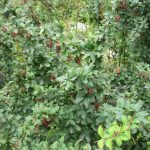  plant for ID: 2 images. which species of berberis ? grows in forests of Shimla Berberis aristata DC. ! I think … may be right as per images at Berberis aristata DC.
MBNN Fortnight::: Berberidaceae:: Berberis for id from VOF-NS 04 : 3 posts by 2 authors. Attachments (3)
This plant which almost grew into a tree was recorded from route to Ghanghariya from Gobind Ghat during VOF Trek..
Wanted to know which species this can be on the basis of these poor pics only..
Can this be a much grown individual of Berberis jaeschkeana ? which is reported from the area.. Berberis aristata – from the size of the plant, the colour of the fruit, the arrangement of fruit along the fruiting stalk… . Berberis sp for ID from near Ukhimath, Uttarakhand-GS06072021-5: 3 images. Berberis aristata DC. ?? Looks close to B. aristata, pls forward the photos of fruits if available. .
Pl. check with Berberis lycium Royle Can this also be Berberis orthobotrys as per your feedback at Berberis pseudoumbellata for validation from Kashmir-GS06072021-3 ? t’s difficult to confirm the ID without checking flower details/mature fruits, but looking at inflorescence, this one looks close to B. aristata.
Berberis asiatica Roxb. ex DC. ! I feel following is more likely though not full details in the image: ok sir . Berberis sp enroute Dev Kyara Uttarakhand- PKA10: 6 images. Please check Berberis aristata DC. ! Berberis aristata in my opinion .
Photographed in Kullu district, Himachal Pradesh
Elevation – 2100 metres
Flowering – May to June & Fruiting – September
This species (B. chitria) is not uncommon in Western Himalayas and surprisingly some of the images of this sp. are already present on our website but are misidentified under page Berberis aristata DC., which is a quite different species and can be distinguished easily from B. chitria based on the below provided key. Berberis chitria is characterized by loosely corymbose-paniculate inflorescence, with some basal flowers usually born in group of three, dark reddish-brown young shoot/branch & peduncle and having oblong-ellipsoid red to brownish ripened berries.
While Berberis aristata is characterized by 8 – 25 flowered raceme inflorescence having no flowers in the group of three, young branch & peduncle brownish – green never red and fruit ovoid to oblong-ovoid, bright red to slightly pruinose blue berries.
By tomorrow I will try to comment individually on earlier misidentified posts of B. chitria present on our website. POWO gives it as a syn. of Berberis aristata DC. I think it may be based on ‘Adhikari, B., Pendry, C.A., Pennington, R.T. & Milne, R.I. (2012). A revision of Berberis s.s. (Berberidaceae) in Nepal. Edinburgh Journal of Botany 69: 477-522′ This recent change in POWO and IPNI is recent and is actually a result of my personal discussion with Dr. Julian Harber as earlier POWO used to give same result what gbif still gives i.e. – Berberis chitria Buch.-Ham. ex Lindl. as accepted name.
There are some nomenclature and type validation issues with the name Berberis chitria, however the plant I have post d is absolutely not true Berberis aristata DC. so for the time being we resolve the nomenclature issues and validate the name I recommend you to please keep my submission only under name B. chitria ignoring POWO. I agree with … Berberis chitria is a very distinct species and should be treated as a distinct taxa, and not under B. aristata. In addition to the differences from B. aristata pointed out by …, leaves of B. chitria are glossy green, sour in taste and sometimes used to make ‘chutney’. The description and drawing of B. aristata as given in Flora Simlensis seems to be that of B. chitria. There are issues with its type validation, and correct author citation, which need early resolution. Many thanks for posting the photos of Berberis. When I revised Nepalese Berberis, I found B. aristata is the most common species that grows across the Himalayas, and was also introduced to many countries as a garden plant. It shows a great range of variations, and I also found some putative hybrids in the wild. Therefore, sometimes the species boundaries are not that clear, and botanists ended up describing a new taxon. It has also been a dumping ground for many other species, you have probably already seen other Berberis species identified as B. aristata. Thanks Dr. Bhaskar Adhikari ji for your detailed comments. . Sattal May 2025 :: Berberis (?) for ID :: ARK2025-022: 2 high res. images. Berberis aristata DC. Please check. .
Berberis for ID from Uttarakhand-GS19092025-3: 3 high res. images. I guess this is Berberis aristata DC. Yes, possible as per images at . Berberis for ID from Uttarakhand-GS19092025-2: 5 high res. images. I guess this is Berberis aristata DC. Yes, possible as per images at . References:
|
Berberis aristata
Updated on October 9, 2025

